Capital Properties – property investment case studies
Guiding Australian Defence Force members through strategic property Investments
How Capital Properties helps ADF members secure financial independence
At Capital Properties, it’s our mission to help Australian Defence Force (ADF) members utilise their disposable income to invest in property and achieve long-term financial independence. Over the years, we’ve had the privilege of guiding many clients through their successful property investment journeys.
In this blog post we’ll share some of our property investment case studies so you can see why property investment is such a great way to build long-term wealth and how we help make it achievable for ADF members like you.
The Capital Properties team are commited to our clients’ financial well-being. That’s why it’s our mission to help Australian Defence Force (ADF) members utilise their disposable income to invest in property and achieve their lifestyle goals. These case studies demonstrate the value of specialist advice in this field.
To get started, book in for our FREE Capital Properties Discovery Session. Or, if you’re due for a review, check out our Capital Properties Pinnacle Support Program.
On the go? Here’s 30 seconds of take outs:
- Capital Properties property investment case studies demonstrate how we help our clients to build long-term wealth.
- Case study 1 – Strategic property investing: This officer used grants & entitlements to save $50,000 & purchase 2 investment properties.
- Case study 2 – Navigating post-covid property market: Post covid investment meant researching population movements & predicted market growth to identify growth suburbs. The outcome: an investment that delivers a strong rental yield & $38,010 in capital gains in less than a year.
- Case study 3 – Maximising value with Capital Properties Buyers Agent: Multiple ADF members who’ve used our Buyer’s Agent service to purchase undervalued properties in the market.
- Case study 4 – Long-term property investment success: Ex-member of the Royal Australian Navy working with Capital Properties to purchase his fourth investment property & optimise his property portfolio.
Keep reading >>
CASE STUDY 1: STRATEGIC PROPERTY INVESTING TO BUILD WEALTH
Client Profile: Maritime Warfare Officer (Navy), ADF
This proactive naval officer approached us early in her career with a goal of building financial independence through property investment. The Capital Properties team worked with her in our FREE Discovery session to ascertain her readiness for investment and clarify her long-term goals. In a follow up Strategy Session, we identified her risk profile and prepared a cash flow analysis to help us select the best market and property criteria that fit her posting locality and her overall lifestyle.
By utilising her grants and entitlements the Capital Properties team uncovered $50,000 in savings allowing this Officer to purchase not one, but two, investment properties, setting her on a path toward financial independence.
Case study 1 property:
– Location: Secret Harbour, WA
– Type: Investment
– Property details: 5 bedrooms, 2 bath, 2 garage, 496m²
– Total purchase price: $495,681 (December 2020)
Land: $228,000
Build: $267,681
Investment outcome:
- Rental yield: $600 per week
- Valuation (2024): $752,000
- Capital gain: $256,319
CASE STUDY 2: NAVIGATING POST-COVID PROPERTY MARKETS WITH EXPERT GUIDANCE
Client Profile: Consultant, Professional Services Industry
In November 2023, a client with a robust understanding of the Australian economy sought our expertise in property investment. And having been on our database since 2016, they knew that the Capital Properties team offered the expertise that they needed to make the move into property investment in this tricky market.
This client was clear in their objectives, to find a property that would attract great tenants, deliver a strong and reliable rental income, and deliver the trifecta of excellent capital gains in the longer term.
Our extensive research on population movements and predicted market growth, identified a suburb in the Moreton Bay Region of Queensland called D’Aguilar. Currently, approximately 17% of D’Aguliar’s occupants live in rental accommodation and that demand is increasing with low housing stock available. The suburb has seen property value growth by 5% over the past year and nearly 34% in the last 2 years. D’Aguilair meets all our selection process criteria for a successful investment property.
The Capital Properties team strategically engaged a builder and developer at wholesale prices and were able to secure a property for our client that was well below the median house price for the suburb. As predicted, the property has already appreciated significantly above the contract price. Construction progress has been swift, with the property currently at the framing stage in under 4 months. Completion is scheduled for Q3 2024, setting the stage for another successful investment venture.
Case study 2 property:
– Location: D’Aguilair, QLD
– Type: Investment
– Property details: 4 bedrooms, 2 bath, 2 garage, 602m²
– Total purchase price: $659,990 (2023)
Land: $294,465
Build: $365,525
Investment outcome:
- Rental expectation: $700 per week
- Valuation (January 2024): $698,000
- Capital gain: $38,010 at settlement (February 2024)
CASE STUDY 3: MAXIMISING VALUE WITH CAPITAL PROPERTIES BUYER’S AGENT SERVICES
Client Profiles: Multiple ADF members
The Capital Properties Buyer’s Agent service specialises in sourcing many different types of property options to suit our client’s goals. We understand that ADF members are often time-poor, so we do the hard work for you. That means researching the current market value for owner-occupied properties and recommending investment properties with higher yield and long-term capital gain potential. We can also evaluate value-added potential with subdivisions and renovations and even advise on industrial and commercial property.
Many of our clients who’ve used our Buyer’s Agent service benefit from our keen eye for undervalued properties in the market. This case study showcases several clients who, with our guidance, made savvy property investments to secure their financial future.
Case study 3 – Property 1:
– Location: Mango Hill, QLD
– Type: Investment
– Property details: 3 bedrooms, 1 Bath, 2 Garage, 741m²
– Year built: 1999
– Purchase price: $750,000 (July 2022)
Investment outcome:
- Rental yield: $650 per week
- Valuation: $841,000 (Recent CBA bank valuation)
- Capital gain: $91,000
This property was identified as being under market value.
This client is currently working with Capital Properties to purchase a second property.
Case study 3 – Property 2:
– Location: Griffin, QLD
– Type: Investment
– Property details: 3 bedrooms, 2 bath, 1 garage, 300m²
– Year built: 2021
– Purchase price: $645,000
Investment outcome:
- Rental yield: $520 per week
- Valuation: $788,000 (Recent CBA bank valuation)
- Capital gain: $143,000
This property was also identified as being under market value. The Capital Properties Buyers Agent negotiated a further discount for our client.
Case study 3 – Property 3:
– Location: Kensington Grove, QLD
– Type: Owner occupied
– Property details: 4 bedrooms, 2 bath, 8 garage/shed
– Year built: 2017
– Purchase price: $780,000
Investment outcome:
- Potential rent: $680 per week
- Valuation: $902,000
- Capital gain: $122,000
This property was purchased in the peak activity period of 2022
and we still were able to negotiate a $19,000 discount from the list price.
Case study 3 – Property 4:
– Location: Thornton, NSW
– Type: Investment
– Property details: 4 bedrooms, 1 bath, 1 garage, 656m²
– Year built: 1980
– Purchase Price: $695,000
Investment outcome:
- Rental yield: $620 per week
- Valuation: $756,000
- Capital gain: $61,000
The Capital Properties Buyers Agent determined that this property was under market value, so we offered full asking price +$5,000 to secure the sale. This client is in the process of refinancing to set up an equity loan for a second property purchase and is well on the way to becoming a switched-on investor.
In each of the property investment case studies above, the Capital Properties Buyers Agent identified properties under market value and successfully negotiated favourable purchase terms. These investments have appreciated significantly, providing our clients with robust rental incomes and substantial capital gains.
CASE STUDY 4: LONG-TERM PROPERTY INVESTMENT SUCCESS
Client Profile: Former serving member of the Royal Australian Navy
This ex-member of the Royal Australian Navy purchased his first investment property (in Bendigo, VIC) with Capital Properties in 2014. Later that year, he grew his portfolio with his second investment property in the Hunter Valley region of NSW.
After his retirement in 2018, he used our services to purchase a third investment property in Brisbane. And now, clearly committed to a long-term investment strategy, he has approached us for guidance in investigating his fourth property purchase and optimising his entire property portfolio.
Like many of our Royal Australian Navy clients he was posted to a Major Fleet Unit at the time of his first and second property purchases. This is a very restrictive environment to facilitate a property purchase let alone do the necessary research to make a well-informed decision. Capital Properties facilitated both property purchases and our Property Investment Tools and Apps with online calculators, checklists etc. helped him track everything from rental yield to tax returns.
And our support didn’t stop there. The Capital Properties Pinnacle Support Program allows all our clients a free annual Strategy Session Review. This review covers the investment property(ies) cash flow position, a comparative market analysis, tenancy and maintenance tips and a strategic plan to continue building wealth.
Because of our detailed planning and ongoing support, this client’s investment has seen remarkable growth with a total capital gain of $1,248,010.
Case study 3 – Property 1:
– Location: Huntly, Bendigo, VIC
– Type: Investment
– Property details: 2 bedrooms, 2 bath, 2 garage
– Total purchase price: $307,000 (2014)
Land: $81,000
Build: $226,000
Investment outcome:
- Rental yield: $430 per week
- Valuation (February 2024): $517,000
- Capital Gain: $210,000
Case study 3 – Property 2:
– Location: North Rothbury, NSW
– Type: Investment
– Property details: 3 bedrooms, 2 bath, 2 garage
– Total purchase price: $395,000 (2014)
Land: $130,000
Build: $265,000
Investment outcome:
- Rental yield: $545 per week
- Valuation (February 2024): $1,057,000
- Capital Gain: $662,000
Case study 3 – Property 3:
– Location: Thornlands, QLD
– Type: Investment
– Property details: 4 bedrooms, 2 bath, 2 garage
– Total purchase price: $534,990 (2018)
Land: $305,000
Build: $229,990
Investment outcome:
- Rental yield: $580 per week
- Valuation (February 2024): $911,000
- Capital Gain: $376,010
Can you relate to any of these property investment case studies? Or are you sitting there thinking you ought to have bitten that bullet years ago? It’s never too late to start. Get in touch with our team asap to see how Capital Properties can help you create wealth from strategic property investment.
Whether you’re just starting your investment journey or looking to optimise an existing portfolio, our team is here to help you navigate the property market with expertise and confidence. Let us help you achieve your financial goals and secure a prosperous future.
Book your FREE Capital Properties Discovery Session today, or discover the Capital Properties Switched-On Strategy Series and Capital Properties Pinnacle Support Program to take you to the next level.
Different types of Property Investor & Owner Occupied home loans
Choosing the right home loan for you
Everything you need to know about different types of home loans
If you’re looking to purchase a home, either for investment or to live in, it’s important to understand the different types of home loans available. In this blog post we’ll discuss what types of home loans there are in Australia so that you can decide which home loan is the right one for you.
Navigating the world of home loans can be daunting. And it’s vital to understand which home loan is best for your circumstances. At Capital Properties, we help Australian Defence Force (ADF) members to invest their disposable income wisely. We understand the unique financial situations of ADF personnel and aim to help you achieve long-term financial freedom through smart property investments.
Our free Capital Properties Discovery Session is a great place to discover which home loan is the right one for you.
On the go? Here’s 30 seconds of take outs:
- Capital Properties can help you understand which home loan is best for your circumstances.
- There are three main types of home loans: fixed, variable and split-rate loans.
- Variable rate home loans have changeable interest rates that fluctuate with market conditions.
- Fixed rate home loans lock in a fixed interest rate for approx. one to five years.
- Split rate home loans split the loan amount into different rate types, combining variable and fixed rate loan features.
- Home loans generally need to be paid in 2 parts: principal and/or interest. We discuss these in depth below.
Keep reading >>
Three types of home loans
In Australia, you’ll usually come across three main types of home loans which vary due to the different ways interest rates are calculated. These are fixed, variable and split-rate loans. The Capital Properties team have collated a list of some of the home loan choices available to you below. If you’re still unsure which home loan is best for your individual circumstance, get in touch with our team and we’ll help you find the best home loan for you.
1. Variable rate home loan
A variable rate home loan has a changeable interest rate that can fluctuate based on market conditions. That means your mortgage repayments could go up or down at any point, and each payment could look different. That obviously requires careful budgeting to make sure payments are met.
Because there is an inherent risk of the loan payments going up as interest rates rise, variable loan rates are usually very competitive. They also often come with features such as the ability to link an offset account or re-draw facility, and often allows the homeowner to make additional repayments.
2. Fixed rate home loan
A fixed rate home loan is a mortgage that locks in your interest rate for a set period, usually between one and five years. This predictability in repayment amounts make budgeting easier and as we’ve seen in recent years can lead to huge savings as interest rates rise. However, it’s also possible that if variable rates fall during the fixed period, you’ll miss out and will have to pay more. Fixed rate home loans are usually less flexible, so often won’t allow extra repayments or there may be limits on the extra amount you can contribute within a set timeframe (e.g. a year). You’re also likely to incur additional fees if you need exit the loan early.
At the end of a fixed term, you can choose another fixed-rate home loan, or move into a variable rate home loan, or a split rate home loan.
3. Split rate home loan
A split rate home loan is sometimes seen as the best of both worlds, offering a mortgage that splits the loan amount into different rate types. A split rate loan combines the features of both the variable and fixed rate loans.
For example, you could split the mortgage in two equal portions, with 50% in a fixed rate loan and the other half in a variable rate loan. The fixed rate provides some stability and protection against interest rate fluctuations, but comes with more flexibility, such as the ability to make additional repayments using the variable-rate portion of the loan.
Repayment options: different ways to repay the loan
There are further options to consider within variable, fixed and split home loans. Most home loans generally need to be paid in 2 parts:
- Principal: This is the sum of money that was borrowed to purchase the home. Each repayment gradually reduces the outstanding principal balance.
- Interest: This is the cost of borrowing the money. The interest is calculated as a percentage of the remaining principal. Interest payments start off higher at the beginning of the loan because it’s based on the overall principal balance, but it decreases over time as the principal is paid down.
You can choose whether to pay principal and interest (P&I), or interest only. We’ll look at these options more closely here:
Principal and interest home loan (P&I)
Principal and interest home loans are the most common of all home loans. Each payment made will reduce the overall principal as well as the interest charges. P&I repayments ensure that the loan will be fully repaid by the end of the term (when all the scheduled payments have been made).
Interest-only home loan
With an interest-only home loan, you only pay the interest for a set period of time, typically up to five years. After that, the loan will revert to a principal and interest loan. As you don’t have to pay the principal at the beginning, the repayments are less than P&I loans. This can be great for investors looking to minimise initial outgoings and maximise tax deductions. However, the interest rates for interest-only loans are usually higher than P&I loans, so you could end up paying more across the lifespan of the mortgage.
First home buyer home loan
Most Australian banks and lenders offer a tailored first home buyer mortgage. These often come with additional features like cashbacks and/or Lenders Mortgage Insurance (LMI) discounts with a 20% deposit. The government also offers incentives to first home buyers, such as the ‘First Home Guarantee’. And don’t forget that there are plenty of ADF benefits for first-home buyers. We’ve covered these in our blog post “Know your alphabet (of first home buyer entitlements).”
The ’Defence Force first home buyers guide’ is an excellent read if you’re looking for your first home loan.
Investment home loan
An investment home loan is a loan that’s taken out to fund the purchase of an investment property, and not for the borrower to live in as a principal place of residence.
Due to potential volatility in the rental market and the possibility of vacancies, investment home loans tend to be considered more high-risk than owner-occupied loans. Therefore, investment home loans will often have higher interest rates and stricter conditions than owner-occupied home loans.
Bridging loan
A bridging loan is a short-term loan, usually up to 12 months, that’s intended to cover the purchase price of another home while you’re still in the process of selling your existing property. Bridging loans are calculated against the equity of your current property and are usually interest-only home loans.
Construction home loan
A construction home loan is a loan taken out to allow for major renovations or if you’re building a new home. This loan allows home buyers to allocate the funds (called a “progressive drawdown”) during each stage of a construction process rather than receiving all the loan at the start. Therefore, the interest only needs to be paid on the amount that’s drawn down, rather than the whole loan amount until the work is complete.
Understanding the different types of home loans is crucial for making smart property investments. Before you decide which home loan is best for you, you’ll need to be sure of your financial situation and whether the loan will help you achieve your long-term financial goals.
At Capital Properties our network partners are here to guide ADF members through this process, ensuring your disposable income works hard to secure your financial future. Talk to us today to learn more about how we can help you secure the best home loan for your circumstances.
*Special Note* This article was written in conjunction with our qualified Mortgage Broker Network Partner
What you need to qualify for an investment property home loan in Australia
Do you know if you are ready to apply for that mortgage?
Its ok if you don’t – We’ll provide everything you need to know about qualifying for a home loan!
Ready to buy your own home or investment property? It pays to be prepared and know exactly what you need to secure a home loan before you start looking at properties.
Qualifying for a home loan involves more than filling in a form online and hoping for the best! It’s important to thoroughly understand your financial situation and any benefits you can take advantage of as an ADF member before you start.
In this blog post we’ll walk you through everything you need to know about qualifying for a home loan so you can start building wealth through property investment for a brighter future.
The Capital Properties team are experts in property investment and it’s our mission to help you make the most of Australian property investment opportunities to secure your financial future.
Our free Capital Properties Discovery Session is designed to take the guesswork out of loan applications and the process of buying your property, whether it’s your first home or an investment property. We’ll make sure you get the best deal.
On the go? Here’s 30 seconds of take outs:
- The first step of applying for a home loan is saving your deposit and knowing exactly where you’re at financially.
- The Capital Properties Online Budget Planner can help you assess your current financial situation.
- Many ADF members are eligible for financial benefits to help them purchase a home.
- Getting pre-approval means you’ll know your borrowing capacity and makes it easier to negotiate with sellers.
- To qualify for a home loan, you’ll need:
– proof of identity, proof of income, savings and assets, liabilities, living expenses, credit history, details of grants or exemptions, employment records & property details.
Keep reading >>
Are you ready to apply for a home loan?
Before we discuss the documentation that you’ll need to apply for a home loan, you‘ll first have to examine your financial situation and make sure you’re in a position to comfortably service the loan. At Capital Properties we have many tools to assist you with this process such as the Capital Properties Online Budget Planner as well as many more online investor resources.
However, the most efficient way to check if you’re ready to invest, is to attend our FREE Discovery Session. During the session we’ll help you determine your long-term financial goals, complete a spending budget, an asset & liability worksheet, and more, to find out exactly where you are financially.
The first step of applying for a home loan – saving your deposit
One of the first steps towards qualifying for a home loan is saving for a deposit. Generally, we recommend a minimum deposit of 10% of the property’s purchase price. Many lenders prefer to see a deposit of 20% which then negates the need for Lender’s Mortgage Insurance (LMI) and often results in a lower interest rate for the home loan.
For some ADF members, this might seem like a daunting task, but with diligent financial planning and our expert guidance, it is achievable. And as Defence Force members there are some financial benefits that you can take advantage of to get you on your way. We’ve discussed these in more depth in our blog post: “Buying a house while in the Defence Force.” But here’s a quick summary of some of these ADF benefits:
ADF financial benefits:
As an ADF member, you may be eligible for various financial benefits that can assist you in purchasing your home:
- Home Purchase Assistance Scheme (HPAS): This scheme provides eligible ADF members with a lump sum of money to put towards purchasing a home.
- Home Purchase or Sale Expenses Allowance (HPSEA): HPSEA helps cover the costs associated with buying or selling a home, such as legal fees and stamp duty.
Defence Home Ownership Assistance Scheme (DHOAS): DHOAS offers subsidies on home loans for current and former ADF members, helping to reduce mortgage repayments and build equity faster.
Sort out Pre-approval
Once you’re sure of where you stand financially, we strongly recommend that you obtain pre-approval for your home loan before you start house hunting. Pre-approval gives you a clear understanding of your borrowing capacity, making it easier to set a realistic budget and negotiate with sellers. At Capital Properties, we can assist you in navigating the pre-approval process, ensuring a smooth and stress-free experience. Our blog post “Why being finance ready pays dividends” elaborates on why pre-approval is crucial.
Qualifying for a home loan
When you’re confident that you’re ready to buy, it’s time to look at what you need to qualify for a home loan. Let’s look at the specific eligibility requirements and documentation you’ll need to apply for a mortgage:
Proof of identity
The lender will need to confirm that you are who you say you are, therefore, they’ll need at least one primary identify document (ID) or two secondary IDs. Here are some common documents you can use:
- Primary ID: Passport, Australian driver licence or Australian learner permit.
- Secondary ID: Australian birth certificate, Australian citizenship certificate, Medicare card or recent ATO assessment notice.
Proof of income
Lenders will want to see evidence of your income, which includes pay slips, tax returns, ATO notice of assessment, employment contracts and a minimum of 3 months of bank account statements. This helps them assess your ability to make regular mortgage repayments. Your proof of income also includes any other sources of income, such as:
- Superannuation
- Share dividends
- Foreign income
Rental income (you’ll also need to present a copy of your current lease agreement and a statement from the property manager/real estate agent).
Savings and assets:
Lenders will generally ask for evidence of your savings and assets to make sure you have sufficient funds for a deposit and to cover additional costs associated with purchasing a property. They’ll look at your bank statements, savings account balances, and information about any investments or other assets you may have such as your superannuation, outright-owned vehicles and shares.
Liabilities:
The bank or lender will also need to assess your liabilities, or debts, such as credit cards, personal loans or vehicle loans.
Living expenses:
You’ll need to provide a breakdown of your monthly living expenses to help the lender determine your borrowing capacity and to make sure you have enough to cover your mortgage without defaulting. This includes regular expenses such as rent, utilities, groceries, clothing and personal care, insurance, phone, internet, TV as well as other discretionary spending.
Credit history:
The bank or lender will also need to assess your liabilities, or debts, such as credit cards, personal loans or vehicle loans.
Living expenses:
You’ll need to provide a breakdown of your monthly living expenses to help the lender determine your borrowing capacity and to make sure you have enough to cover your mortgage without defaulting. This includes regular expenses such as rent, utilities, groceries, clothing and personal care, insurance, phone, internet, TV as well as other discretionary spending.
Credit history:
Your credit history plays a significant role in determining your eligibility for a home loan. Lenders will review your credit report to evaluate any outstanding debts or missed payments. Generally speaking, the higher your credit score, the better your chances are of scoring home loan approval.
Details of grants or exemptions:
You should provide the lender with details of any grants or exemptions you’re eligible for, such as the VIC Shared equity scheme, or the Regional Home Guarantee-5% deposit scheme.
Employment stability:
Lenders love to lend to people who can demonstrate stable employment conditions. Being employed full-time for a year or more is considered ideal. You’ll need a copy of your employment contract along with confirmation of your basic pay and any allowances for exercises and deployments.
Self-employed individuals must show 2 years of tax returns, Australian Taxation Office (ATO) assessments and the last 2 consecutive years’ profit and loss from their business. If you receive a government income, they’ll need to see a letter from Centrelink confirming your benefits.
Property details:
As part of the home loan application process, you’ll need to provide details about the property you intend to purchase. The lender will ask for the sale contract, any building inspection reports as well as your solicitor or conveyancer’s name and contact details. Or, if you’re building, they may ask to see the formal building tender with plans and specifications.
To learn what happens once you’ve submitted all of these documents, check out our blog post “The finance process for the Defence Force Property Investor”.
Believe us when we tell you that organising all the necessary documentation upfront makes the home loan application process much more straightforward. It’s a highly frustrating scenario if you’re waiting to move on a property and facing delays because the bank can’t process your application quickly because they weren’t given the information they need.
At Capital Properties, we can guide you through this process step-by-step. We’ll make sure you’re making the right investment decision for you, help you gather the required documents and navigate any challenges that might arise along the way. Contact us today to learn more about how we can help you qualify for a home loan and invest in your future through property ownership, or book your FREE Discovery Session ASAP.
*Special Note* This article was written in conjunction with our qualified Mortgage Broker Network Partner
When we first meet many of our Clients, they tell us that the idea of financial freedom feels elusive. With the cost of living as high as it’s been for decades, many people struggle to look at the bigger picture and understand how to make their hard-earned money work well for them.
At Capital Properties, we’re big fans of the ‘Rich Life’ concept inspired by Ramit Sethi. Sethi is known globally as a financial guru whose net worth surpasses $25 million. His best-selling book “I will teach you to be rich” and follow-up Netflix show “How to get rich” offer a refreshing perspective on how to achieve long-term prosperity and happiness. The Rich Life concept emphasises conscious spending, smart investing, and personal fulfillment. In this blog post, we’ll discuss the key principles of the concept and how to apply them to your life as an Australian Defence Force member.
The team at Capital Properties help Australian Defence Force (ADF) members apply the Rich Life concept to invest your disposable income in property, so that you can secure your financial future and create the life you want to live. Book our FREE Capital Properties Discovery Session to get started.
If you’re already on board, why not take advantage of our Property Investment Tools & Apps and essential resources from our Capital Properties Pinnacle Support Program.
On the go? Here’s 30 seconds of take outs:
- Ramit Sethi is the author of bestselling “I will teach you to be rich” and follow-up Netflix show “How to get rich”.
- Sethi coined the Rich Life concept to emphasise conscious spending, smart investing, and personal fulfillment.
- Sethi’s 8 rules for a Rich Life are:
- Your Rich Life is unique to you
- You need to take control
- Don’t wait to become an expert
- It’s OK to muck up
- Play offense, not defence
- Don’t wait until retirement
- Focus on the big wins
- Give back
- Capital Properties can help you apply the Rich Life concept by:
- Providing personalised investment strategies
- Education and ongoing support
- Expert mentoring
- Automation and efficiency
Keep reading >>
How the Rich Life concept come about
Sethi’s success story began with him creating a blog “I will teach you to be rich” in 2004 (while studying technology and psychology at Stanford). His next project, a humble $4.95 eBook, sold over a million copies, catapulting his business into a multi-million-dollar empire and inspiring millions of people with his straightforward approach to personal finance. His advice goes beyond traditional financial advice as he urges his followers to create a life that aligns with personal values.
Our Capital Properties Goal Setting tools and workshops encourage a similar approach to finance. We’ve discussed the importance of goal setting in many of our previous blog posts, such as “Review your goals & financial vision – what drives you?”, “Dream big to live life large through goal setting” and “How are you tracking toward your lifestyle goals?” Our aim at Capital Properties is to equally inspire you with the knowledge and tools for strategic financial planning and intentional living to create your Rich Life.
Understanding the Rich Life concept
The Rich Life concept is based on using your money to help you live a more fulfilling life. The key is to identify what truly makes you happiest in life – what fills your bucket? For some people, it means having the freedom to travel and see the world. For others it’s having the ability to enjoy quality time with the people that mean the most to you. And for others, it might mean splashing out on designer clothes or fast cars. It’s completely different for every person.
Then, once you’ve figured out what makes you truly happy, you direct your resources, i.e. your time, energy, and money towards those passions, and give little attention to the things that don’t bring the same level of joy to your life.
Key principles of the Rich Life concept
In his website ”I will teach you to be rich”, Sethi lays out his “rules” to create a Rich Life. Here’s a quick summary of these 8 rules:
1. Your Rich Life is unique to you
Everyone’s version of a ‘rich’ life is different. As we just said, for some, it might mean traveling the world, while for others, it could be owning a dream home or driving a luxury car. The key is to define what a Rich Life means to you and pursue it without apology. As Sethi notes, “Your Rich Life is yours—not mine, not your friends’, and not your parents’.”
2. YOU need to take control of your Rich Life
Financial independence is about taking charge of your own destiny and not leaving things to chance or allowing someone else to lead the way. Sethi tells us that he turned down lucrative venture capital offers that came with management restrictions so that he could maintain total control of his business.
He encourages people to take ownership over their financial future by setting goals, examining their spending habits and creating systems to manage their finances. Thus, making sure their money works for them in ways that align with their passions and goals. He recommends prioritising spending on the things you love, so you can save on the stuff you don’t. If this sounds like a daunting exercise, our Capital Properties Goal Setting Guide is a great place to start.
And yes, that means that you also need to create a budget! Our online Capital Properties Budget Planner makes this process much easier.
3. Don’t wait to become an expert – start now
Many people think they need to wait until everything is perfect before they take action. We hear it all the time. “I’ll invest when I’ve got that promotion, or when I’ve done more research, or when I’ve finally organised a savings plan”! Waiting until circumstances seem “perfect” before you take action is debilitating. Sethi’s “85% Solution” advocates for getting things nearly right rather than waiting for the perfect moment.
This principle is fundamental for new property investors. Starting with a well-thought-out investment plan, even if it’s not flawless, is far better than doing nothing at all. Similarly, he suggests following a simple fitness program, so that he gets some exercise every day, rather than making grand plans and not sticking to them.
4. It’s OK if you muck up
Creating your Rich Life isn’t always going to be easy. It’s inevitable that you’ll make mistakes, with money and relationships. And your goals for your Rich Life might change over time. But that’s all part of the learning. Don’t let it stop you from getting started or forging ahead to reach your goals. When things get tricky, reach out to mentors who can help you get back on track.
5. “Play offense, not defence”
In Sethi’s own words, rule number 5 is to “play offense, not defence”. What he means is that it’s important to take determined action to achieve your goals. That means creating a budget and sticking to it. Make sure you’re getting the best deals financially, e.g. questioning bank and service charges etc. Work with experts to stay informed of potential investment opportunities and be fully aware of what your financial status is so that you’re ready to act. Sethi suggests setting up automated banking so that you can allocate a certain amount of your income (e.g. 20%) to savings and investments. This saves time and ensures consistency and discipline in financial management.
6: Don’t wait until retirement to live a Rich Life
So many people get caught up in planning for the future, they neglect to live their Rich Life every day. We all know the future is not guaranteed, so although you do need to have a plan for retirement, it’s important to make the most of
now. And Sethi agrees, it’s vital to invest in personal growth, experiences, and relationships.
Again, your everyday Rich Life could look quite different from others. It might mean enjoying that avocado on toast without considering the cost, taking your partner away for a spontaneous weekend, or buying that car that makes you drool every time you think about it! The idea is to make your money work for you so that you can indulge every now and then without worrying about jeopardising your future. As Sethi says “No one wants to be a rich 95-year-old with regrets”.
7: Focus on the big wins
Sethi says to focus on the big wins, in other words, stop sweating the small stuff and really focus on the areas in life that you’ll make the most gains. For example, working in a rewarding career and taking advantage of further training and study opportunities that’ll help advance your career and your salary. Prioritise your physical health and maintain the important relationships in your life. Start investing early and build relationships with experts who can guide you along the way. And don’t spend any time or money on the stuff you don’t care about.
8: Create a ‘generous’ life
Sethi is an advocate for creating a generous life – one that follows the old adage “It’s better to give than to receive”. Once you’re living your Rich Life it’s important to share your time, money, resources, and/or talents with the world. Whether that means being able to volunteer at your kids footy, donate to friend’s fundraisers, or support a charity you care about. Giving back is good for the soul.
Applying the Rich Life concept with Capital Properties
At Capital Properties, we understand the unique challenges and opportunities faced by ADF members. Our goal is to help you leverage your disposable income to build a secure and prosperous future through strategic property investment. Here’s how we can help you apply the Rich Life concept:
- Personalised investment strategies – We tailor investment plans to suit your individual goals and financial situation, ensuring that your journey to financial freedom is as unique as your vision of a rich life.
- Comprehensive education and ongoing support – From understanding market trends to navigating the intricacies of property investment, we provide the knowledge and strategies you need to make informed decisions. And the support doesn’t stop with your first investment, we designed our Pinnacle Support Program to ensure you have ongoing guidance.
- Expert mentoring – The Capital Properties team is made up of investment experts, financial planners, buyer’s agents, real estate agents, mortgage brokers, property tax account specialists, quantity surveyors, conveyancers, property managers and more. If you need expert help, we’ve got you covered.
- Automation and efficiency – Our Property Investment Tools and Apps are specifically designed with you in mind. We can help you set up systems to automate savings and investments, ensuring that your financial growth is consistent and hassle-free.
By partnering with Capital Properties and adopting the principles of the Rich Life concept, ADF members can achieve financial freedom and live richly in every sense of the word. Book your FREE Capital Properties Discovery Session today and let us help you make your Rich Life a reality.
Our Capital Properties Switched-On Strategy Series and Capital Properties Pinnacle Support Program will make sure you’re able to successfully navigate these changes in the Australian property market.
What’s happening in the Australian property market?
If you’re considering investing in the Australian property market, then it’s important that you’re aware of current housing trends. From the ongoing effect of the COVID-19 pandemic, increasing interest rates and the housing crisis, navigating the evolving landscape of real estate in 2024 is best done with the help of property market experts.
In this blog, the Capital Properties team take a look at the key housing trends that have emerged over the past few years and what they mean for property investors across different states and territories.
At Capital Properties, we’re committed to helping ADF members invest their disposable income wisely to achieve long-term financial freedom. That means staying up-to-date with housing trends and navigating the property market to take advantage of any opportunities that arise.
Our free Capital Properties Discovery Session is a great place to examine current housing trends and start your well-informed property investment journey.
On the go? Here’s 30 seconds of take outs:
- The Australian property market is still feeling the effects of the COVID-19 pandemic.
- There was a 16% increase in capital-to-regional movement since 2019.
- Property values in combined capital cities rose by 10.2% in over the last year.
- Almost each state & territory experienced record high property values in early 2022 & even though they’ve since fallen, property prices in most areas are still higher than pre-pandemic.
- High interest rates & rising living costs have put pressure on the property market.
- Rental vacancies are at their lowest since 2018.
- The national median rent is $600 per week.
- The government’s promise to deliver 2 million new properties by 2029 is falling short of its target & shows no sign of relieving the housing crisis.
Keep reading >>
Post COVID housing trends – prioritising lifestyle
I know we all want to forget it ever happened, but the reality is that the aftermath of the COVID-19 pandemic has reshaped the Australian property market and we’re still feeling the effects.
In the early days of lockdowns Aussies sought out tree and sea-changes for a better work-life balance in unprecedented numbers. Access to remote work resulted in an increase in demand for larger homes with dedicated office spaces, outdoor areas, and proximity to essential amenities. We’ve talked about this in our blog “The big shift towards the ideal Australian Lifestyle”. Even now, the latest Regional Movers Index shows a 16% increase in capital-to-regional movement since 2019. But that trend doesn’t mean that cities are missing out, with an increase in value by 10.2% in property values over the last year in the combined capital cities.
Let’s take a closer look at what’s happening in each state and territory.
State and territory housing trends:
– New South Wales (NSW) & Victoria
The demand for city living stayed strong in Sydney and Melbourne, despite the challenges posed by high interest rates and the cost of living. NSW house prices grew to record highs in January 2022, climbing to 27% but have since fallen by 12%. Victoria hit its peak of 17.3% in February 2022 but has experienced a 9% fall. The current city market looks stable, but there’s an increased demand for more affordable housing options in outer suburbs and regional areas.
– Queensland
Sunny Queensland had a huge surge in demand for lifestyle properties, particularly in coastal regions like the Gold Coast and Sunshine Coast. Brisbane experienced an overall growth of 42.7% in property values by June 2022 and only a 10.9% fall.
And this housing trend looks set to continue as Queensland continues to attract both owner-occupiers and investors seeking the ultimate Aussie lifestyle.
– South Australia, Tasmania & Northern Territory (NT)
These regions have seen a mix of housing trends, with some areas experiencing significant growth due to the increased desire for space and relaxed lifestyle. However, some others struggled with affordability issues and limited supply. Adelaide had a growth of 44.7% in house values post pandemic and the market has remained strong with a fall of only 2.4%.
NT prices grew just over 31% during COVID with only a 2% fall, whereas Hobart saw a boom of 37.7% growth with a sharp fall of 12.9% in less than a year.
– Western Australia (WA)
Perth and other regional centres in WA experienced strong growth as remote work opportunities increased. The market peaked in July 2022 at 25.9% and has only dropped by 0.4%.
The state’s relative affordability compared to its eastern counterparts made it an attractive option for property investment. And a relatively high average salary in WA (approx. $1988 per week) means that the increased interest rates and cost of living seem to not have had the same detrimental effect as seen in other states.
High interest rates & the cost of living
The current high interest rates and rising cost of living have certainly put pressure on the property market, making affordability a concern for some potential investors. However, while these factors present challenges, they also create opportunities for many savvy investors.
With interest rates expected to stabilise in the coming months, it’s a great time for ADF members to explore property investment strategies that align with their long-term financial goals.
Rental prices
Although many homeowners are feeling the pinch and some prospective homebuyers might feel their dream of home ownership is getting further and further away, many renters are also having a tough time.
Right now, rental vacancies are at their lowest since 2018. Renters are battling in a highly competitive market, with the obvious outcome of increased rents.
Every Australian city has experienced an increase in the median price for rentals, for both units and houses. At the end of the March 2024 quarter, the national median rent advertised on realestate.com.au reached $600 per week. That’s an increase of 3.4% over the quarter and a 9.1% increase from the year prior. And with the current housing crisis, this shows no sign of letting up.
Navigating the housing crisis
With Australia’s population continuing to grow at a rapid pace, there’s no sign of relief for housing shortages and low rental stock. The national population increased by a record 659,795 people from September 2022 to the same month in 2023.
548,770 individuals migrated here from overseas, so as they’re unlikely to own their own property, they’ll be relying on rental accommodation – at least for the short term. Even the Federal Government’s Housing Accord goal to build 1.2 million new properties over five financial years from mid 2024 is looking like it’s too little, too late. In fact, Australia needs to approve about 80,000 more homes every year in order to meet the new dwellings target and we’re falling woefully behind. This chronic housing shortage is likely to keep driving up property prices and rents throughout 2024.
Again, this presents both challenges and opportunities for potential property investors. By leveraging expert advice and focusing on emerging growth areas, investors can navigate the housing crisis and continue to build a robust property portfolio.
What’s next for the Australian Property Market?
Economists and property experts will all have varying opinions on what the current housing trends means for the future of the Australian property market. From predictions of the market stabilising – along with interest rates, to the possibility of a surge in the market due to ongoing demand and supply, the team at Capital Properties will be keeping our fingers on the pulse of the housing market.
As always, the Capital Properties team are here to support ADF members to become informed investors by providing expert advice, personalised strategies, and access to premium investment opportunities across Australia.
The best place to start is our FREE Capital Properties Discovery Session which will help you identify what you need to start investing and give you an idea of what we bring to the table as property investment specialists. Then our follow up Strategy Sessions will help you create a plan to find your perfect investment and work towards achieving your goals.
You can also click the following links to access our monthly Australian Property Market Report and our free online Property Investment Tools and Apps.
How to help you choose the right Property Manager
Find yourself a Property Manager who’ll save you time, money and your sanity!
Why you need a good Property Manager
We know this isn’t the first time you’ve heard us recommend the services of a Property Manager. In fact, we always recommend you get a Property Investment A-team around you once you start investing. But the question of why you need a good Property Manager still comes up in conversations with our Clients.
The thing with ADF members is we’re great at thinking we can do it all ourselves. We know property investment is an excellent way to secure our financial future and we know managing expenses is crucial. So, the temptation to DIY property management is understandable. But managing a property can be challenging, especially when you’re leading an already hectic lifestyle due to your service commitments. Tenants can be demanding, and even ‘easy’ tenants require ongoing management. That’s where a professional Property Manager can be worth their weight in gold. The right Property Manager will make sure your investment prospers while you get on with work, life and everything else.
Our Capital Properties team is dedicated to helping you invest without stress. If you haven’t been already, we invite you to our FREE Capital Properties Discovery Session to learn the tricks of the trade for hassle-free investing.
If you’re ready to take the next step, our Property Investment Tools & Apps and essential resources from our Capital Properties Pinnacle Support Program will help you get there.
On the go? Here’s 30 seconds of take outs:
- The right Property Manager is crucial to the success of your investment.
- Property Managers are responsible for screening & managing tenants, daily admin, property maintenance, managing disputes, mitigating risk & keeping on top of finances.
- Choosing the right Property Manager with Capital Properties means you get a Property Manager who offers:
– Personalised service
– Experience & expertise
– Great value for money
– Ongoing support & advice
Keep reading >>
What does a good Property Manager do?
A good Property Manager plays a vital role in ensuring your property is looked after properly and remains profitable. Here’s some of what the role entails:
– Tenant screening
The most obvious task a Property Manager undertakes is the screening of potential tenants to ensure they’re the right fit for your investment property. That means they’ll check tenants’ references for rental history, making sure they’re likely to pay rent on time and aren’t liable to damage your investment. If you have a moment, you can read our earlier blog ‘How to find quality tenants’.
– Tenant management
Unfortunately, the work doesn’t stop once you’ve got tenants in place. A thorough lease agreement is necessary to ensure the rules of tenancy are set out clearly. It’s also necessary to undertake regular property checks and deal with any maintenance issues that pop up. Then there’s rent collection, including any additional agreed fees. To make sure all of this goes smoothly, you’ll need regular communication to avoid any risk of rental arrears or disputes.
– Administration
It’s always surprising how much admin is required to deal with tenant queries and manage property maintenance. The right Property Manager will handle all the day-to-day admin, so you don’t have to get bogged down with it.
– Property maintenance
Regular property inspections are essential to ensure your investment stays in good condition. A good Property Manager will conduct routine inspections to identify and correct any maintenance issues early on as well as making sure your property complies with the latest regulations.
– Tenant disputes
It’s not unusual for issues to arise between you and your tenants. Most problems will fall within the daily admin, however some might need more time and experience to deal with. For example, non-payment of rent, negotiating a rent increase, or handling unreasonable requests from your tenants. The right Property Manager will handle tenant complaints and try to find a mutually beneficial resolution. If the worst happens and you can’t find a resolution, the Property Manager can take action to legally evict the tenants.
– Managing risk
Another thing your Property Manager is essential for, is being able to identify any potential risks and taking proactive measures to mitigate them. That includes making sure your property is compliant with local, state and federal laws. They’ll also make sure you have the right insurance coverage in place, and they’ll select low-risk tenants to protect you and your investment.
– Keeping on top of property finances
Property Managers will help you determine the ideal rent price to make sure your investment is profitable while also staying competitive to attract good tenants. They’ll keep records of all financial transactions, helping you to stay on top of your property’s expenses and gross income.
Choosing the right Property Manager with Capital Properties
At Capital Properties, we understand the unique challenges ADF members face when investing in property. We’re committed to helping you navigate these challenges and make sure your investment journey is stress-free. Here’s how we help you choose the right Property Manager:
– Personalised service
We listen to what you need and offer solutions that are tailored to your requirements. Our Property Managers will manage as much or little as you’re comfortable with and will help you decide if you need regular updates or periodic reports to keep you informed at every stage.
– Experience and expertise
We partner with experienced Property Managers who have a wealth of knowledge in the real estate industry and local rental markets. They understand the busy lives of ADF members and do everything they can to make your investment work for you while you get on with your life.
– A great investment
Capital Properties recommends Property Managers who provide cost-effective property management solutions to make sure you maximise your returns. Our Property Managers minimise unnecessary costs but will strive to maintain full tenancy, regular property maintenance and ultimately increase the value of your investment.
– Ongoing support and advice
With the right Property Manager, their support won’t end once your property is tenanted. They’ll offer ongoing support and guidance, assisting you with any queries or concerns you may have throughout your investment journey.
Choosing the right Property Manager is crucial to the success of your investment. At Capital Properties, we’re dedicated to helping ADF members like you find the right Property Manager to manage your investment effectively.
It’s our mission to help you make informed decisions and achieve long-term financial freedom. Get in touch today to learn more about our property management services tailored for Defence personnel.
And while you’re here, check out the Capital Properties Switched-On Strategy Series and Capital Properties Pinnacle Support Program.
Make the most out of the silly season and book your end/start-of-year review with the Capital Properties team
‘Tis the season to be jolly, and what better way to celebrate than by taking a moment to reflect on your property investment strategy with Capital Properties? As the year draws to an end and a new one about to begin, it’s the perfect time to evaluate your property investments, set new goals, and make any necessary adjustments so you can hit the ground running in 2024.
In this blog post, we invite you to join us for an end/start-of-year review to help secure your financial future for the years to come. So, grab a cold one and let’s explore why a property investment check-up is the best way to close out your year.
The Capital Properties team live and breathe property investment for ADF members, and it’s our mission to make sure we help you achieve your property investment goals to reach future financial security. Our FREE Capital Properties Discovery Session is a great place to start, and we have tools and strategies to help you every step of the way.
On the go? Here’s 30 seconds of take outs:
- Capital Properties clients use proven property investment strategies to weather the storms and make the most of the opportunities in the Australian Property Market.
- An end-of-year review will make sure you stay on the path to financial success. The review covers:
- Lifestyle and financial goals
- Assessment of current property portfolio
- Optimisation of property investment strategy
- New opportunities identified
- Prep for tax season
- We’ll also cover latest property data, market analysis, research as well as your cash flow position and explore the options available to you, whether you’re ready to grow your portfolio, or make changes to get you closer to that point.
- Book your end-of-year review now so you can hit the ground running in 2024.
Keep reading >>
Looking back to look forward
Before we welcome in the new year, it’s only natural to look back at the past one and reflect on the successes and challenges we’ve faced. In 2023, Australian Defence Force (ADF) property investors encountered plenty of opportunities and challenges in the Australian property market. From the highs of unprecedented rental demand in some areas and attractive government initiatives, to the lows of building supply issues and soaring interest rates, we’ve had a hell of a ride.
Capital Properties clients have used our proven property investment strategies to weather the storms and stay ahead of the game with growing portfolios and strong capital growth across all their investments. And we want to see you continue to succeed in 2024 and beyond. That’s why we encourage you to take advantage of a Capital Properties end-of-year review and make sure you stay on the path to financial success.
Why an end-of year review?
The comprehensive Capital Properties end-of-year review will allow you to:
-
Review your lifestyle and financial goals
It’s easy to get busy and bogged down in the craziness of day-to-day life, especially if they involve training, exercises, and deployments. So, it’s important to speak to someone with an objective view to make sure you are still in line with your goals.
-
Assess your current property portfolio
Together we can analyse your current property investment(s), assess their performance, and make sure they still align with your financial and lifestyle objectives.
-
Optimise your property investment strategy
We’ll make sure you stay on track by working with you to optimise your property investment strategy to maximise returns and minimise risks.
-
Identify new opportunities
The Australian property market is constantly evolving. The Capital Properties experts will help you discover new opportunities that may be worth exploring in the coming year.
-
Prepare for tax season
According to the Australian Taxation Office (ATO), 9 out of 10 rental property investors make errors in their tax returns, especially when it comes to interest deductions. The Capital Properties team can help you ensure your investments are structured in a tax-efficient manner to avoid facing the wrath of the ATO when it comes to tax time.
What does the end/start-of year review cover?
As well as making sure you have a clear vision of your goals and the strategy you need to get you there, our end of year review will cover some essentials such as:
-
Latest property data and research
We’ll re-evaluate your investment property(s) cash flow position and comparative market analysis, including:
- RPdata suburb and statistics reports for each property
- Residex suburb reports
- The latest Forecast ID demographic reports
- Desktop and full valuations
- Rental manager feedback and reviews
- Vacancy rates
-
Strategy development
We’ll look at the options available to you, whether you’re ready to grow your portfolio, or make changes to get you closer to that point. Our finance team will confirm your new borrowing capacity and discuss the next steps. If it suits you better, we can do all, or most of this, over the phone. Your options might include:
- Option A. Capacity for a new purchase – If you’re in the position to explore your next property investment opportunity, we’ll help you get the ball rolling.
- Option B. Increasing capacity – If you’re not ready for your next investment just yet we’ll share tips that will increase your capacity and help you get closer to your goals.
Option C. Consolidation – We can help you work out if you should consolidate your finance, find better interest rates, and reduce your investment/personal debt.
What’s next?
We know that the unique demands of Defence life mean you don’t always have time to stay updated and make sure your investment(s) is working the hardest for you. We created the Pinnacle Support Program to make sure you’re supported the whole way through your property investment journey. And we believe the end of the year is the perfect time to evaluate your property investments and set the course for the year ahead.
It’s also a chance for us to say thank you for your continued trust in our team. Your support is greatly valued, and we look forward to celebrating your successes in the years to come.
Get in touch now to book your end-of-year review and make sure you’re still on track to reach your financial and lifestyle goals.
If you’ve got some time, you can check out our FREE Property Investor Tools and Apps and download a copy of our book, Property Investment SOP – essential reading for all property investors and first home buyers.
Are you ready to take your property investment journey to the next level?
At Capital Properties, we understand that achieving success in property investment requires a strategic approach. That’s why we’re excited to introduce you to the Capital Properties Property Investment Planner.
This 4-in-1 planner is designed to help you reach your goals of successful property investment for future financial security so you can create the life you dream of.
Invest in your future with the Capital Properties Property Investor Planner, the best 4-in-1 planner for property investors in Australia! Then come along to our FREE Capital Properties Discovery Session where we’ll help you put these plans into action.
Our Property Investment Tools & Apps and Capital Properties Pinnacle Support Program will support you every step of the way.
On the go? Here’s 30 seconds of take outs:
- As ex-ADF members, Capital Properties understand the barriers and opportunities ADF members face when it comes to property investment.
- The Capital Properties Property Investment Planner was created by Capital Properties founder, Marcus Westnedge.
- The user-friendly planner has tools, tips, and strategies to help you stay focused & learn to prioritise goals & tasks.
- This is Australia’s best property investment planner with daily inspiration, mindset evaluation, hourly schedule, personalised goal setting, and there’s nothing stopping you from starting right now!
Keep reading >>
Designed by ADF Investors, for ADF Investors
The Capital Properties Property Investment Planner was developed by seasoned property investors who understand the challenges and opportunities in the Australian property market, as well as the barriers and opportunities you’ll experience as ADF members.
Marcus Westnedge, the founder and director of Capital Properties, brings a wealth of experience to the world of property investment. He joined the Royal Australian Navy at 17, bought his first property at 19, and built a multimillion-dollar portfolio before leaving the Navy.
He created a 7 step to successful property investment strategy that’s helped thousands of ADF members get on top of their financial literacy and use their disposable income to build generational wealth.
And because Marcus is passionate about helping others achieve property investment success, he’s developed this unique Property Investment Planner to get you started.
What makes this Property Investment planner the best?
It’s not just another generic planner; it’s a roadmap to help you navigate every step of property investment.
This comprehensive planner is packed with tools, tips, and strategies to make sure you stay focused and learn to prioritise goals and tasks like a seasoned property investor. It covers everything you need, including:
- Building better habits: Success in property investment starts with cultivating the right habits. Our planner provides insights and exercises to help you stay focused.
- Increase productivity: We’ll show you how to maximize your productivity, so you can make the most of your time and resources.
- The ‘Well-Formed Outcome’: Learn this specialised goal-setting technique to create a plan of attack and hit each of your targets.
- Self-evaluation for success: Self-awareness is key to successfully setting goals, tracking progress and making necessary adjustments.
- Yearly ‘mind map’: A visual mind map helps you maintain clarity and focus on your property investment goals and plans for the year ahead.
- Annual budget template: Get a handle on your finances with our accurate annual budget template. Know where your money’s going and plan accordingly.
- ‘Personal Action Sheet’ and ‘Personal Action Plan’: Monitor your progress toward your goals with our monthly templates.
- Weekly strategy planning: Consistency is key. Our weekly strategy planning templates make it easy to stay on track.
- Daily ‘to-do’ lists: Get stuff done. Each day will bring you closer to your investment goals.
How the Capital Properties Property Investment Planner helps you stay on course
Like every well-executed plan, you need to measure what matters. That’s why our planner is designed to prevent procrastination and keep you focused on your end goal. Here’s why it’s your key to success:
- Daily inspiration: You’ll find a dose of inspiration to keep you motivated every day.
- Mindset evaluation: Discover what a winning mindset looks like and adjust yours for success.
- Hourly schedule: Keep track of your daily activities and create healthy habits that’ll keep you accountable.
- Personalised goal setting: Define what success looks like to you. What are your career, financial, and personal goals? Think about family time, spiritual growth, recreation, and your long-term goals.
- User friendly: We’re all about helping you achieve success in property investment, so our planner is easy to use and gets you there faster.
- Undated: You can start using it right now, no need to wait for a specific date.
Your journey to property investment success starts here. With our Switched-On Strategy Series and Capital Properties Pinnacle Support Program you’ll have the full support of our experienced team.
So, make the first move and make sure you don’t miss out on this opportunity to take control of your property investment future. Purchase your copy of the Capital Properties Property Investment Planner today and set yourself on the path to success.
(I’d be assuming you’d have a good understanding! But just in case) Who and what is DHA?
Defence Housing Australia (DHA) was established in 1988 to provide housing and related services to Australian Defence Force (ADF) members and their families. This includes all members of the Defence Force, Officers and employees of the Department of Defence as well as anyone that’s contracted to provide goods or services to the ADF and their families.
DHA operates as a corporate Commonwealth entity and is one of nine Government Business Enterprises (GBEs) that has a Services Agreement with the Department of Defence. The DHA is represented in the Government by two Shareholder Ministers: the Minister for Finance and the Minister for Veterans and Defence Personnel.
DHA is one of the largest property managers in Australia, with approximately 18,500 properties under management. About 70% of Defence housing is owned by property investors.
In this blog post, we’ll take a deep dive into DHA and answer the question “how does DHA stack up?” and more importantly, is DHA a good investment strategy for you?
The Capital Properties team are passionate about empowering you to develop the best investment strategy for your situation. Whether you’re just starting out, or growing your portfolio, our FREE Capital Properties Discovery Session will help you achieve your property investment goals for future financial security.
On the go? Here’s 30 seconds of take outs:
- Defence Hosing Australia (DHA) provides housing and related services to ADF members and their families throughout Australia.
- DHA is one of the largest property managers in Australia.
- About 70% of Defence housing is owned by property investors.
- DHA generates more than $1 billion of revenue per year.
- ADF members have several housing options: Service Residence, Members Choice Accommodation, Living-in accommodation, & Rental Assistance.
- DHA leases city apartments, townhouses & free-standing houses.
There are pros and cons of investing in DHA:
Pros of DHA investing:
- Long-term lease options with guaranteed rental income
- One service fee covers property inspections, annual rental adjustment, tenant management & property maintenance.
- Monthly statements & online property management.
- End of lease cleaning with appliance checks.
Cons of DHA investing:
- Must buy/build in specific locations within 30kms of defence bases.
- DHA have higher property management fees than other managers.
- Restricted on rental rates/lease agreements.
- DHA properties are sold at market value so you may not get maximum value if selling mid-lease.
Keep reading >>
DHA’s mission
DHA’s main mission is to “provide adequate and suitable housing and related services.” So, what does that mean exactly? Simply put, DHA works with the Australian Federal Government to administer Defence housing policy and provide housing and related services to Australian Defence Force (ADF) members and their families.
These services include:
- Providing a property portfolio and managing and maintaining ADF housing.
- DHA Housing Consultants help ADF members to find housing solutions throughout Australia.
- Assist with bookings and allocations.
- Manage allowance payments for ADF members in rental accommodation.
- Meet Defence housing demands by building and purchasing properties.
- Redevelopment of existing properties to meet Defence standards.
DHA’s commitment to shareholders
DHA doesn’t receive funding from the Federal Budget, but instead makes money from commercial rent, fees, and charges from Defence services, as well as sales and lease of property investments. Older properties that don’t meet current Defence standards, or excess land is occasionally sold to create revenue. Overall, DHA generates more than $1 billion of revenue per year. These profits allow payments of dividends to the Australian Government (based on 60% of net profit after tax).
DHA services to Defence
The Department of Defence is responsible for determining pay conditions for ADF members, including entitlement to subsidised housing. ADF members who don’t own a suitable home in their posting location are often eligible for housing assistance. There are several housing options available to ADF members and their families:
-
Service Residence (SR)
A Service Residence (SR) is a subsidised house or apartment that Defence provides to eligible ADF members who have Accompanied Resident Family (ARF) in a housing benefit location near Defence bases and offices throughout Australia. ADF members who don’t have a resident family (MBR) and members who have unaccompanied resident family (URF) might be eligible to live in a surplus Service Residence.
-
Member choice accommodation (MCA)
Member choice accommodation (MCA) are off-base rental properties and are available in most housing benefit areas, located close to base or city centres. These properties have 24-hour maintenance services, can be reserved without inspection and don’t require bonds or fixed term leases. The rent is automatically deducted from ADF pay.
-
Living-in accommodation (LIA)
Living in accommodation (LIA) are rooms that are allocated when the Defence member is in transit and needs a room for a short stay. There are 5 levels of LIA accommodation, usually single rooms with either shared bathroom or ensuite.
-
Rent Allowance
Rent allowance subsidises the cost of renting a property in the private rental market. ADF members are responsible for finding a suitable rental property, and signing the lease/paying the bond etc. They will then be paid a fortnightly Rent Allowance subsidy through the Defence pay system.
What are the DHA property requirements?
DHA seeks different types of properties depending on locations, e.g. city apartments, townhouses or free standing dwellings or townhouses. Each of these properties have certain criteria. For example, a free-standing property must:
- Be within 30kms of a Defence base.
- Have at least 3 bedrooms with WIRs – at least one with ensuite.
- Must have a fully functional kitchen, dining area/room, lounge room and laundry.
- Bathroom with separate shower and bath and separate toilet.
- Lock-up garage.
- Fully enclosed rear yard.
Location of DHA properties
- ACT – Canberra & Queanbeyan
- NSW – Glenbrook, Newcastle, Nowra, Sydney, Richmond & Wagga Wagga
- NT – Darwin
- QLD – Brisbane, Gold Coast, Cairns, Ipswich, Toowoomba & Townsville
- VIC – Mornington Peninsula, Melbourne& Wodonga
- WA – Perth & Rockingham
- SA – Lefevre Peninsula, Campbelltown, Vale Park, Hewett & Adelaide Hills
Note, property criteria and locations are subject to change. See full DHA eligibility criteria here.
Is investing in DHA a good idea?
OK, now that we know how it all works, let’s investigate how does DHA stack up from an investment point of view? At Capital Properties, we know property investment is a great way to turn your disposable income into future financial
freedom. Our mission is to help you – Australian Army, Royal Australian Air Force and Navy recruits get on top of financial literacy and make the most of property investment opportunities to secure your financial goals.
Investing in DHA certainly has an appeal. It defines your market and ideal property for you, making those decisions of where to invest a little easier. It offers a secure rental yield, almost guaranteeing a long-term income. But like all investments, it’s important to explore each of the advantages and disadvantages before you make an investment decision. Let’s explore the pros and cons of investing in DHA in greater detail…
Pros of leasing to DHA
- In some cases, DHA will commit to lease before you build or buy.
- Long-term leases (usually 3, 6, 9 to 12 years), with a possibility of extension.
- Guaranteed rental income – paid in advance from the date of settlement and even when the property is vacant.
- DHA finds and manages tenants, making it easier for time-poor investors.
- Service agreements with only one service fee.
- DHA provides regular property inspections and annual rental adjustment in line with market valuations.
- Carries out property maintenance including most non-structural repairs.
- Regular independent rent reviews.
- Provides monthly statements and access to online property management software.
- End of lease cleaning with appliance checks.
- Somewhat predictable capital gains as DHA selects properties based on local amenities/access to transport etc.
Cons of DHA property investment
The main argument we regularly hear against DHA property investment is that although the monthly yield is reliable, there’s often less opportunity for capital growth, particularly in regional areas. Let’s look at other potential cons:
- You’re limited to purchasing/building in specific locations within 30kms of defence bases.
- DHA have high property fees at 16.5% (or 13% for townhouses) compared to most property managers (approx. 4-10%).
- Owner is still responsible for outgoing costs such as council, water and strata rates, land tax, insurance, termite inspections and some repairs and maintenance.
- Limited control over rental rates.
- Lease agreements include a variable extension period, potentially adding another 3 years to the lease (at DHA’s discretion).
- Being locked into long-term lease, and tenants means it’s trickier to sell mid-lease.
- Also, because of the long-term lease, the property can only be sold to investors and not owner-occupiers, limiting your buyers. This makes some banks reluctant to lend money for DHA investments.
- There may also be restrictions on marketing the property, so it could take longer to sell.
- DHA properties are sold at market value, which means the price is fixed and non-negotiable. So, you can’t negotiate lower when you buy, and you might not get maximum value if you sell mid-lease.
How does DHA stack up for you?
Investing in DHA has its merits, offering a stable income, long-term lease agreements with less stress about managing tenants and vacancies. However, it does come with potential downsides, like high property management fees, limited control over rental rates and potentially lower capital gains.
Like all property investments, whether it’s the right move for you, or not, depends entirely on your individual situation, including your risk tolerances and ultimate investment goals.
At Capital Properties, we’ll help you develop a property investment strategy that suits your circumstances. As former ADF members ourselves we know DHA investing inside and out and can help you make decisions based on our years of experience and market knowledge. Start by booking into our free Discovery Sessions.
And while you’re here, check out our FREE Property Investor Tools and Apps and download a copy of our book, Property Investment SOP – essential reading for all property investors and first home buyers.
About this project
I’d been keeping an eye on these Industrial Warehouses for a while as we’d often drive past on the way to school drop off.
My idea was to do an office conversion!
Below are the stages of the build, if you have any questions about this project email [email protected]
We are super stoked with the result! Its great to be working from here!
See a copy of the original concept plans Capital Headquarters.
Stage 1.
Concrete polish & installation of ‘Corflute’ (The white stuff on the deck) to protect the concrete polish.

Stage 2.
Delivery of the flooring supports & Frames.

Stage 3.
Mezzanine floor construction.


Stage 4.
Frame construction.
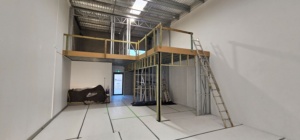
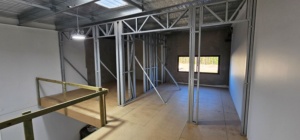
Stage 5.
Air Conditioning install.
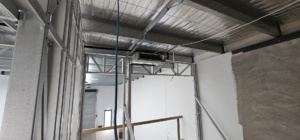
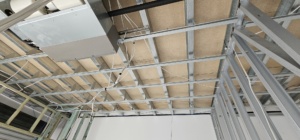
Stage 6.
Air Conditioning frame & Ground Floor ceiling frame & ceiling battens.
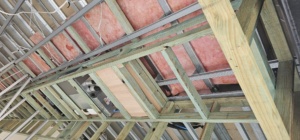

Stage 7.
Insulation Install.
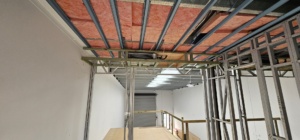

Stage 8.
Plaster Board install.
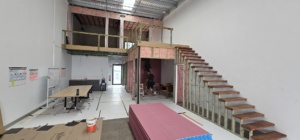
Stage 9.
Plastering stage.


Stage 9.
Painting & Electrical fit off.



Stage 10.
Stair case & glass doors, windows, & mezzanine flooring install.
I opted to run with a different look for the stairs, rather than going with the typical steel stringer & timber treads, a frame was constructed which was rapped with a James Hardy product cement cladding with an expressed joint look.



Stage 11. (Final Stage)
Glass balustrade.
As soon as the glass balustrade was installed, it really set the look & feel of the space. It looked amazing.

Finished photos


Interested in a project like this? Contact Us




